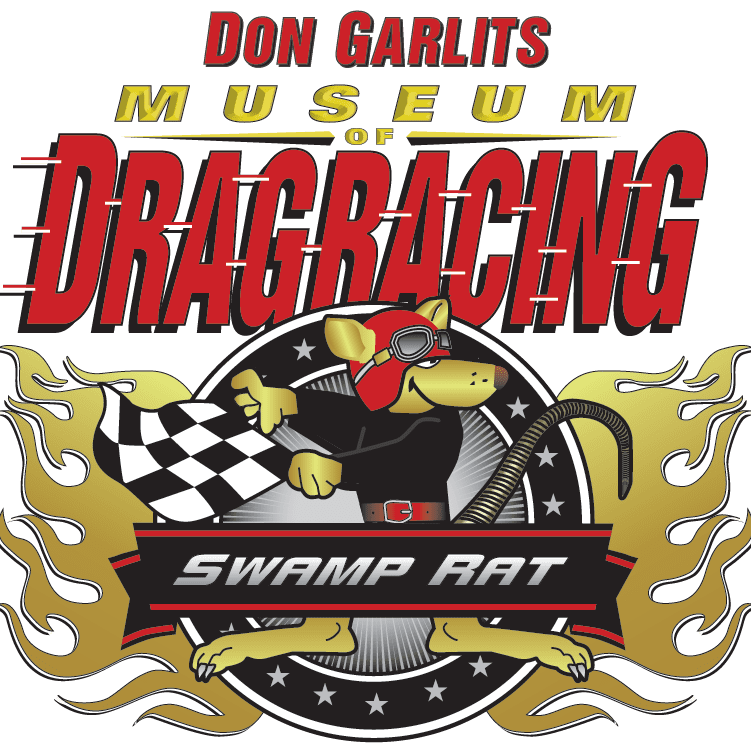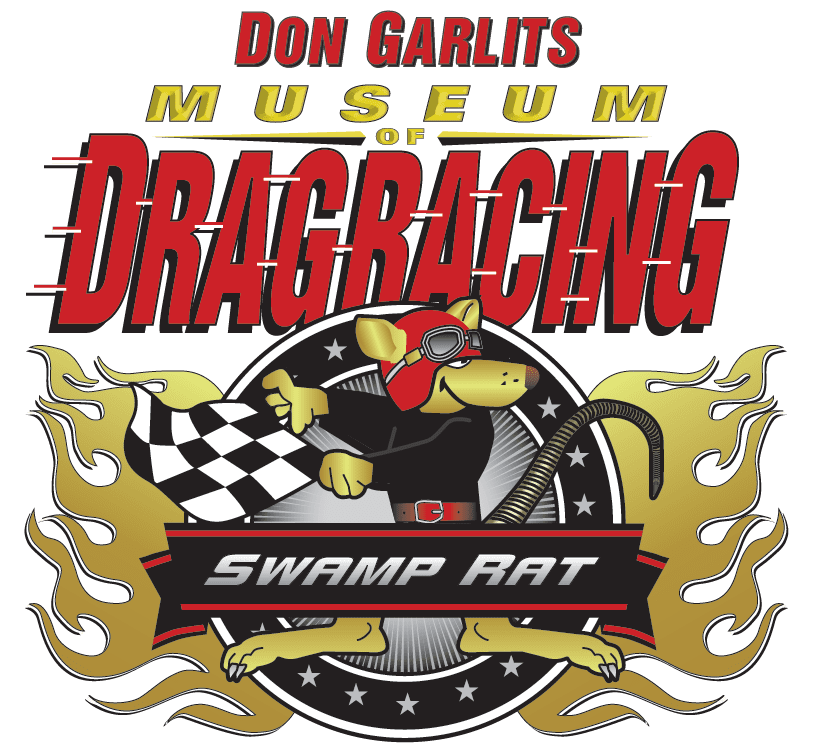2011
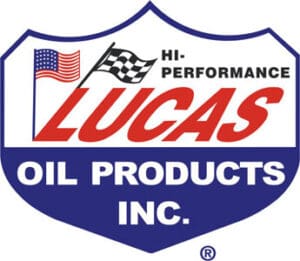
Event Sponsor Lucas Oil Products Held on Thursday March 10, 2011 Hilton University of Florida
Conference Center, Gainesville, Florida.
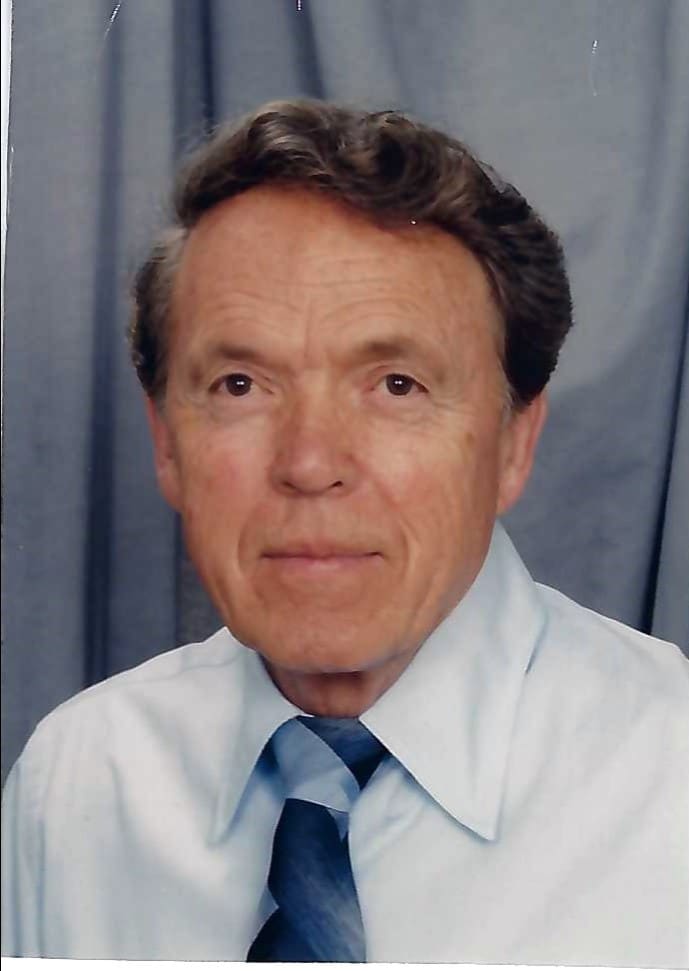
Ed Almquist
Founder’s Award
As a legendary motorsport pioneer, Ed Almquist has done it all-racer, inventor, manufacturer, merchant, and author. Many original and patented inventions for the giant racing and performance industry are a result of Ed’s innovative “Imagineering” over a span of 60+ years.
After writing the world’s first speed manual copyrighted in 1946 (which helped “kickoff” hot rodding as a new post-World War II motorsport), Ed founded Almquist Engineering. It was a bootstrap enterprise, started with a dream, that flourished and became the largest maker of hot rod and racing equipment east of California. Later, the Almquist manufacturing division became Sparkomatic Corporation (one of the first volume suppliers to the nation’s speech shops).
Once the nation’s premier motorsports mail order icon (disturbing millions of catalogs) in the 1940s to the 1970s, Ed Almquist introduced many industry first-including: popular hard core, race winning equipment, universal floor shifters, compound manifolds, tuned exhaust systems, lifetime spark plugs, style setting fiberglass bodies, and accessories. Long before the days of plastic credit cards, Almquist introduced the first and only retail credit plan for racers and rodders (a good idea before it’s time so it bombed).
Ed is one of the few industry car guys capable of taking a new idea all the way to a finished product and then peddling it successfully. Today, many of Ed’s inventions, such as Sparkomatic spark plugs, floor shifters, gas saving lubricants, and air ram cold air induction (introduced many years before GM “copied” the concept), are still in use nationally on street, drag strip, and circle track cars.
Often called one of the “Granddaddy’s” of American stock-car and drag racing, Ed has been a member of the Society of Automobile Engineering since 1961 as well as a charter member of the NHRA. Ed is the author of “Hot Rod Pioneers”, a 400-page book featuring famous personalities who created the fastest sport on wheels.
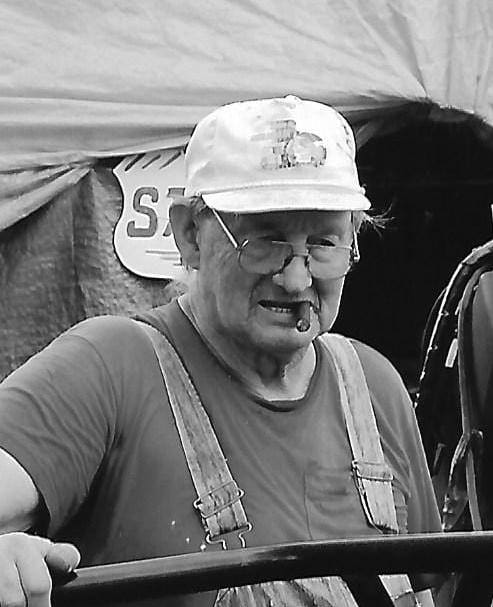
Fred Sibley Sr.
Fred Sibley senior started working on cars when he was around 14 years old, not to go racing but simply to repair them. He attended the local drag strip the first year the NHRA Safety Safari came to Indiana and was hooked on the sport. His first race car was a set of rails powered by a modified four-cylinder Model A Ford engine. His next move was to replace the four-banger with a stout GMC six-cylinder powerplant. That was okay but like every racer he believed he needed more power to go faster so in 1951 he built a new “slingshot” dragster that was powered by a 12-cylinder Ranger Aircraft engine. By this time Fred was working with Art and Walt Arfons at their shop so he was exposed to the jet powered vehicles they were racing. In 1951 he followed the Ranger powered dragster with his first jet car.
In 1964, Fred took over some of the driving chores for Arfons jet powered “Green Monster” dragster but preferred to build and drive his own cars. In fact, Fred debuted the first jet powered funny car which boasted a sleek Plymouth Barracuda body wrapped around a J-46 jet powerplant. After the Cuda Fred switched from funny cars back to dragsters when he built his famous “Quarter Horse” J-46 powered dragster. After the Quarter Horse, Fred introduce a string of jet powered dragsters that carried names that are still legends and this arena, names like: “The Hugger”, the J-33 powered “Fat Albert”, “Gypsy Moth”, and “US-1” a car that was formerly owned by Bill Fredrickson and rebuilt by Fred.
Always looking to introduce something different and unique, Fred introduced his first jet powered truck, the “Maxi Taxi” in 1980 which he still drives at exhibition and nostalgia events today. Fred hasn’t confined his driving to jet drag racing, in 1964 he said a class record of 353 MPH at Bonneville and later made a run in the “Goodyear Wingedfoot” streamliner of 421 MPH.
Fred’s contribution to the sport extends beyond just building and driving classy, exotic racecars, he and Jim Hollinger teamed up to design and build the first “roller starter”, a Chevy powered set of rollers that was installed at the starting line and eliminated the old push-starting process. Fred also worked with Jim Deist in developing different parachute designs and other pieces of safety equipment, many of which Fred still produces today.
At 76 years old Fred still actively participates at various events, driving his jet powered truck and the US-1 at nostalgia events. He also still has the original V-12 Ranger powered dragster that is in mint condition in which Fred will give a demonstration run with if asked to do so.
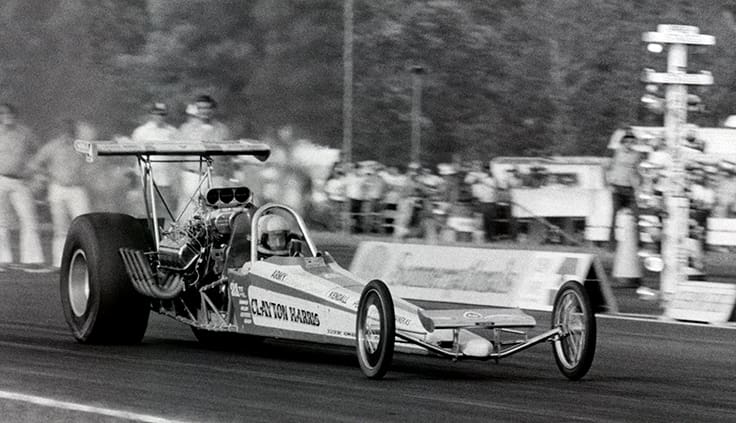
Clayton Harris 1939-2000
Clayton Harris was born in Columbus Mississippi and started his racing career in 1959 at the wheel of a blown Chevrolet powered top gas dragster; which was the same car he drove to win NHRA’s Division II Top Gas Championship in 1966. In 1968, he made the move from top gas to top fuel owning and driving a blown Chevy powered dragster. Most of his racing up to this time was on a local basis where he earned the reputation as a tough competitor but in 1971 Clayton teamed up with Jack McKay to drive McKay’s New Dimension Homes dragster. In 1972 Harris really moved into the national scene by being the first to record four consecutive 6.20 seconds ET and set low ET at the NHRA US Nationals in Indy. He followed this performance at the NHRA World Finals where he was runner-up and shortly after that capture the NHRA Eastern Conference Top Fuel Championship.
In 1973 Clayton decided to return to the status of owner/driver and fielded an all-new AA/Fuel Dragster. As an independent he managed to win the NHRA Summernationals in Englishtown, New Jersey, that season and repeated his 1972 feet of winning the NHRA Eastern Conference Championship again. In 1976 Harris one the IHRA US Open Nationals in Rockingham, North Carolina, in 1977 he won the IHRA Fall Nationals in Atco, New Jersey, in 1978 he topped the fuel ranks at Darlington, South Carolina, by winning the IHRA Winter Nationals and later that year he won the IHRA Dixie Nationals in Atlanta, Georgia. He finished the year as the 1978 IHRA Top Fuel Champion. In 1979 he finished second in the IHRA Championship race and decided to retire.
Harris return to drag racing in 1980 when he teamed up as crew chief with Richard Holcomb in a Harris designed and built radically different dragster that featured an extremely narrow rear end among its other offbeat innovations. The team’s efforts produce the third four second run ever at an IHRA national event in Ennis,Texas. In 1992 Harris returned to the driver seat as much to develop a revolutionary fingerless hydraulic pressure plate for the clutch as for the competition. In 1995 he was once again in the winner’s circle this time winning the IHRA Super Nationals in Steele, Alabama. Unlike today’s modern race teams where every job has a specialist along with a crew chief, Clayton was owner, driver, mechanic, crew chief, and tow truck driver.
Before the 1995 season’s end, Clayton again gave up the driver seat, this time to pair up with Paul Romine as the crew chief of Paul’s Carquest Auto Parts sponsored nostalgia top fuel dragster. The pair notched a victory at the prestigious Bakersfield California March Meet in 1996 and later at a race in Morocco, Indiana they became the first nostalgia top fuel dragster to move into the five second bracket. The team captured three more wins on the nostalgia circuit that year but decided they wanted to return to more conventional top fuel dragster class in 1997. In 1997 the team captured the IHRA Top Fuel Championship and returned in 1998 to make it back to back championships. After their 1997 debut in top fuel dragster on the IHRA circuit, the duo reset the associations elapsed time record five times, won seven IHRA national events, won three IHRA drag racing championships, and were the first car to top 320 MPH and set the IHRA ET record at 4.676 seconds.
Unfortunately, Clayton died in a private airplane crash in 2000 but along the way he made some serious waves in the top fuel dragster wars and is credited with three mechanical patents with several more still pending.
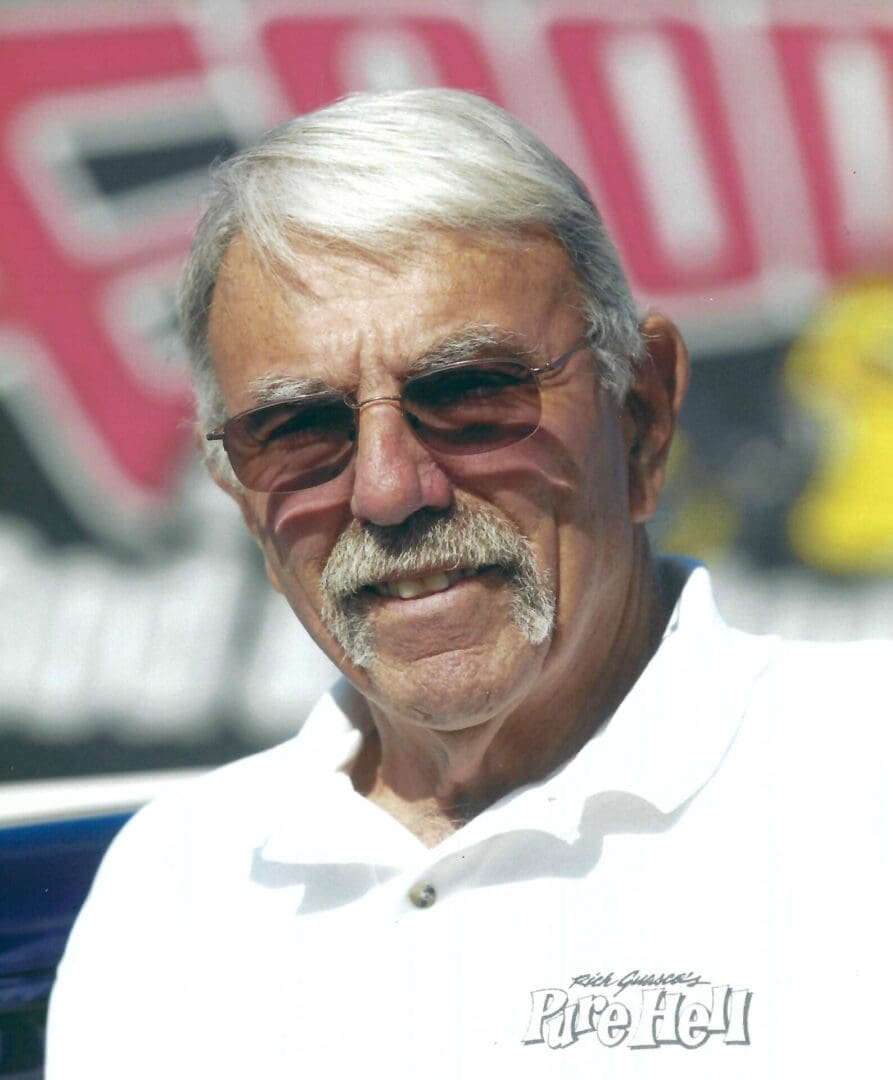
Rich Guasco
Rich Guasco started his love affair and racing career by building his first street roadster at the ripe age of 12. His first actual race didn’t come until he was 14 and that was at the old Belmont California 1/8-mile track. By the time he was 15 he was involved in building and driving a flathead powered belly tank. Next came an A/Street Roadster that he entered for the first time in 1959 at Kingdom Raceway.
Shortly after that he went into the Army but upon receiving his discharge in 1961, he built his first Chevy powered gas dragster. One of the most memorable outings was the old Denver, Colorado track where he won top Eliminator in AA/Gas dragster then proceeded to add nitro and beat the top fuel dragster of Kenz & Lesli. After that event he sold the car and built a new AA/Fuel dragster. This car was very competitive from day one but on January 13, 1963 Rich had a terrible accident that nearly took his life. A year later, Rich completed the rebuilding of the dragster but traded it to his friend Pete Ogden for a nearly completed roadster Pete was building. Rich debuted the car, a Chevrolet powered 92-inch wheelbase Bantam bodied roadster designed by his friend Rich Railton. This was to become the first in a series of “Pure Hell” cars. Rich drove the roadster for its shakedown runs but shortly after that permanently retired from driving and focused on building and tuning the engines for the now famous series of roadsters. The original Pure Hell roadster was the first FF/FA to run over 180 MPH and under 8.50 seconds. In 1968 the Chevrolet engine was replaced with a Chrysler that made its first appearance at the Winternationals that year and set a new class record of 207 MPH. By this time there was a new driver at the wheel, Dale Emery. Dale set the fuel altered class on fire, eventually turning in a best speed of 218 MPH and a low ET of 7.27 seconds. The combination of one of the most beautiful cars ever raced, Dale’s unique and colorful driving style, and the speed and ET’s turned by the car made it into one of the most famous cars of the sport still today.
Rich is still the only hot rodder in the history of the sport to win the America’s Most Beautiful Roadster crown with his purple 1929 roadster in 1961 and his front engine top fuel dragster the next year.
After the unbelievable success of the first “Pure Hell” roadster and his success in the top fuel arena, Rich decided to switch to a Dodge Demon bodied AA/Fuel Funny Car in 1970 and in 1973 notched his first NHRA national event win when, with Dave Beebe at the wheel they won the Spring Nationals in Columbus, Ohio. While they were on the tour later that year, the Demon was destroyed in a highway accident. His next AA/Funny Car was a Lil John Buttera production that was successfully driven by some of the most noted drivers of that time including: Dave Beebe, Richard Tharp, Pat Foster, and Elwyn Carlson.
In 1992, Rich restored the original Pure Hell roadster and with Larry Huff driving debuted the car at the Goodguys vintage drag races that same year. With more horsepower than the original car ever had coupled with the original short 92-inch wheelbase, the car was plagued with handling problems. To solve this problem, Rich had his friend Dave Uyehara build a modern, longer wheelbase version of Pure Hell that, with Larry have driving, eventually went on to set a record time and ET of 238 MPH and 6.30 seconds.
While Rich Guasco retired from active racing in 2000, he hasn’t given up his love of cars and has spent his time since focusing on restoring some of his original cars and building some new ones. He also still attends selected events such as the Goodguys Nostalgia Nationals in Bowling Green, Kentucky, where he served as the official “Hot Rod Hero” for the event and most of the NHRA Hot Rod Reunion’s.
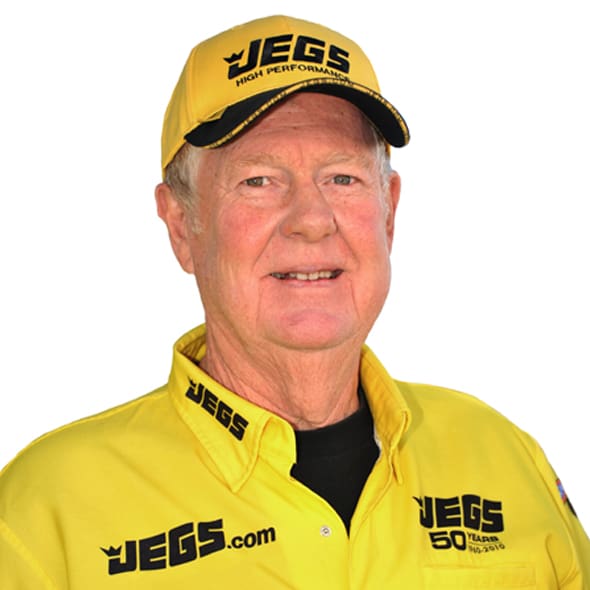
Jeg Coughlin Sr.
Like most of the people involved in the sport of drag racing, Jeg Coughlin Sr. began his involvement in the sport during his high school years. His first effort behind the wheel was in a 1936 Ford five window coupe which doubled as a daily driver and a weekend racer. In 1959 he entered a blown Chevrolet powered 1955 Chevy two-door sedan in D/Gas as his first participation in a national event and went home with the class trophy. From that humble beginning Jeg went on to become a dominant force in a variety of cars and as many different classes.
In 1960 he opened the doors to Jeg’s Automotive, Inc. in Columbus, Ohio. Over the past 50+ years the company has evolved into Jeg’s High Performance and has become one of the largest and most successful mail order speed equipment business is in the world. Nearly three decades after Jeg’s original speed shop was born, he helped his four sons John, Troy, Mike, and Jeg Jr purchase the operation and under their collective guidance the small family business continues to be a dominant force within the performance industry and the racing world.
While building his business into what it is today, Jeg was also busy on the race track. Over the years he has participated in top fuel dragsters, top alcohol dragsters, funny cars, pro-stock, A/Gas Supercharged C/S, D/Gas Supercharged C/S, C Stock, C Gas, modified eliminator, pro comp, and super eliminator. The results of all his participation reads like something out of a movie. He notched four NHRA North Central Division Championships, three in AA/Fuel dragster in 1977, 1978, in 1979. One in pro comp in 1976. He also accumulated a total of 30 NHRA di0visional wins that includes 11 consecutive victories in top alcohol dragster, six in pro comp, four in AA/Fuel dragster, one in super eliminator. The rest are spread out over the various remaining classes he participated in.
Jeg Sr’s career isn’t just highlighted with his on-track victories, he is a member of the Hot Rod Magazine Hall of Fame, the NHRA North Central Division Hall of Fame, the Olentangy Business Hall of Fame in Powell Ohio, and in 2002 received Car Craft Magazine’s highest award, the Ollie Award. On top of all these awards, Jake was named the Ernst & Young Master Entrepreneur of the Year recipient in 2002. He and his family also created the privately funded Jeg’s Foundation for Cancer Research and the “Racing for Research” program which has raised several million dollars for cancer research since its inception.
Jeg Sr’s off-track activities also include supporting his children and grandchildren and their many activities. His four boys each actively compete in drag racing. John in comp and top dragster, Troy in pro mod, Mike and top sportsmen, and five-time NHRA champion Jeg Jr. racing in a variety of different classes but most visible in pro stock. Now the third generation of Coughlin’s can be found competing in super comp, late-model, junior dragsters, and quarter midgets. As a side note, the Coughlin clan’s activities aren’t limited to racing, they are also into golf, ice-skating, horse riding, and stick and ball sports so Jeg Sr. has established a well-rounded legacy.
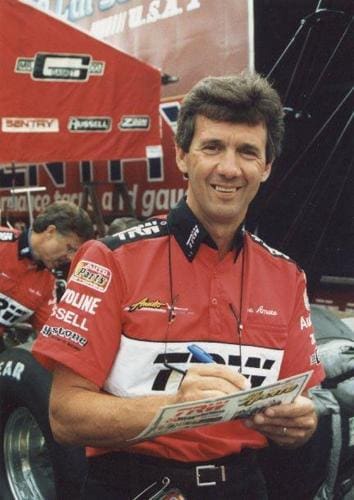
Joe Amato
When Joe Amato was 11 years old, his dad opened an auto parts store, A&A Auto Parts, where Joe went to work and began learning what would ultimately become his prime career. Also, at that time, some of his dad’s employees were racing on weekends and started taking Joe with them and it wasn’t long before he was hooked. Joe’s first car was a 1953 Ford that he started modifying shortly after he got it. When Joe was 16, his father was forced to quit working after undergoing open-heart surgery and Joe made the decision to quit school and run the auto-parts store full time. Despite the workload of running an auto parts store, Joe found time to go racing on the weekends and soon learned that the more successful he was on the track, the more business he did. By the time Joe was 20, the auto-parts store had grown into five stores. Unfortunately, at the age of 32 Joe’s dad died leaving him the job of managing an expanding business specializing in speed accessories. Ultimately, A&A Auto Parts and Keystone Automotive Warehouse became one of the most well-known and largest suppliers of parts and accessories in the automotive business.
In his early racing days, Joe raced locally starting with a variety of cars including a 1958 Pontiac, a 1932 Chevy, a 1940 Chevy, and a 1948 to frame altered Fiat. Following this, Joe raced alcohol funny cars with moderate success but in 1979 he switched to an alcohol dragster and notched his first NHRA national event win in pro comp at the Gatornationals in Gainesville Florida. He followed that win with another NHRA national event when at the 1980 Le Grand Nationals-Molson in Canada and in 1981 took home three class Wally’s from NHRA national events.
1982 was Joe’s debut year in top fuel and while he did not win a Wally his first year, he did manage to place six in the championship points race. 1983 was a much better year with Joe winning three NHRA national events and challenging Gary Beck for the championship title. At the 1984 Gatornationals in Gainesville, Florida Joe and crew chief Tim Richards debuted a new chassis design that included a different rear wing that was mounted higher and further back than previous designs. This new design enabled Joe to become the first top fuel dragster to top the 260 MPH marke along with three NHRA national events and the Winston World Championship that same year.
Joe continued his winning ways the next couple of years and in 1987 he made the sports first 280 MPH run followed in 1988 with his second Winston World Championship. 1990 was to be considered Joe’s most successful year when he recorded six national event wins along with his third world championship. 1991 and 1992 didn’t see as much total event wins but he did compile an impressive total of eight more NHRA national event wins and won his fourth and fifth Winston World Championship.
The next couple of years didn’t give Joe the success he was used to but in 1996 he hired Jimmy Prock as the new crew chief and from then through 2000 they recorded 18 more national event titles and produce the sport’s first 4.5 second ET clocking with a 4.595 second run at the 1996 Western Auto Nationals in Topeka, Kansas. His final driving career victory in top fuel dragster came when he won the Keystone Nationals in Maple Grove, Pennsylvania for the second time in as many years. While Joe never experienced a serious crash, the stress of thousands of trips down the track took their toll on his eyes and he decided to retire from driving. Not wanting to leave the sport completely Joe hired Darrell Russell to drive his top fuel dragster the next year and they opened the 2001 season by winning the AutoZone Winternationals in Pomona, California. In 2005, Joe reluctantly made the decision to retire from the sport completely and pursue some of his other interests which included Joe Amato Properties, under which he owns two shopping centers, he is also involved in developing housing projects. He also owns Joe Amato’s Collectible Cars, a venue for buying and selling classic muscle cars.
Joe Amato’s list of accomplishments in the sport of drag racing read like a movie script but they came only with total dedication and uncompromising work ethic. While a couple of his compilations have been eclipsed since his retirement, at the time of his retirement the list of accomplishments included: 52 NHRA victories, five NHRA top fuel championships (three straight years), top 10 point standing finishes 18 consecutive seasons, named number nine on NHRA’s top 50 list, 56 number one qualifying spots in NHRA events, 99 top fuel final appearances in NHRA events, six wins in the Budweiser Shootout, a member of the Cragar four second club, member of the Slick 50 330 MPH club, and the first driver to exceed 260 MPH and 280 MPH.
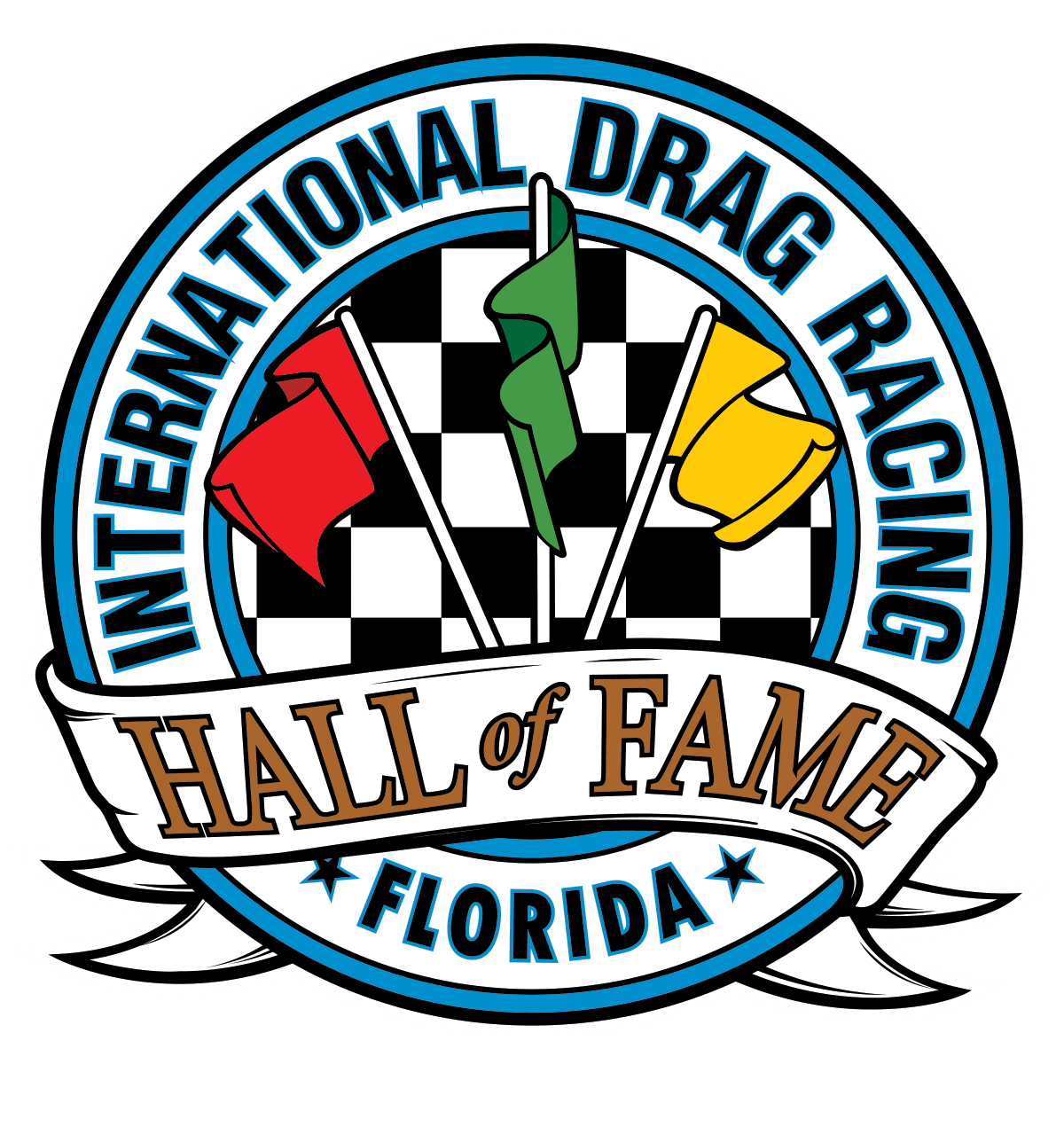
Leonard Abbott 1931-1984
Leonard moved to San Diego, California from Arkansas shortly after he graduated from high school and where he was joined shortly by his brother Norris. Upon his arrival in San Diego, Leonard went to work in a small machine shop where he learned to master the machines that would later allow him to bring his dreams to reality. Also, not long after his arrival in San Diego, he became the proud owner of his first dragster, powered by an injected Chevy engine and driven by his brother Norris. When Norris wasn’t able to drive, another San Diego local, Leroy Goldstein would take over the driving chores. The two brothers soon built their lives around the drag racing world and Leonard began designing and building parts for racing. In 1958, Norris was killed in a racing accident at Paradise Mesa Race Track which led Leonard to turn more and more to the business side of the sport. While he spent a lot of time working on improving the performance portion of the sport, he was particularly interested in improving the safety of the sport.
In 1966 Leonard, by now was working out of a rented space in the back of a small automotive engine building shop, B&L Auto Parts, founded Lenco Racing Transmissions and began designing his first product aimed strictly at the drag racing market, and overdrive transmission. Unlike some of the equipment available at the time, this was not a rebuilt factory unit but a purpose-built piece designed for dragsters, funny cars, and comp cars. In 1965 Leonard put together a top fuel dragster which he ran locally in which became the test car for his products. That same year Leonard built a Dodge Charger funny car that Joe Lee drove for him. Like the dragster, the funny car was also a combination test car and a very competitive race car. By 1969 he was producing and selling his overdrive unit and before long racers such as Gene Snow and Don Prudhomme were showing the racing world what a great product this was.
While he raced mostly at the local Southern California tracks, Leonard did attempt the touring circuit for a short time with both the AA/Fuel dragster and the AA/Fuel funny car but decided it interfered with the business end of Lenco and also his developing of new products and gave it up to concentrate on building the business.
In 1971 with the help of Jack Jones, Leonard developed and began marketing and under drive transmission that was well received but never became as popular as the overdrive unit. The next project Jack and Leonard developed was the “air shifter”, a pneumatically operated clutch unit that soon altered how the drive train of a great many race cars were set up. Leonard went on to develop many other products including and overdrive fitted fuel pump for the fuel-burning classes that was an instant success along with several variations of his clutch systems. Leonard was the first person to introduce port nozzles on his fuel dragster but a small miscalculation on the way he set them up pretty much destroyed his engine. Later on, Stu Hilborn asked Leonard if he was going to continue developing the system and when Leonard said no, he and Hilborn worked together to develop their use further and before long Hilborn was successfully marketing the units. In addition to the land-based racing products, Leonard also developed a number of products for the marine and oval track arenas of racing.
Leonard succumbed to cancer 1984 at the age of 53 but left his legacy in the form of his company, Lenco Racing Transmissions, that is still one of the most popular and reliable sources a product for both racing and street performance enthusiast.
